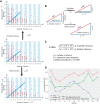Comprehensive Evaluation of Relapse Risk (CERR) Score for Colorectal Liver Metastases: Development and Validation
- PMID: 32181531
- PMCID: PMC7356794
- DOI: 10.1634/theoncologist.2019-0797
Comprehensive Evaluation of Relapse Risk (CERR) Score for Colorectal Liver Metastases: Development and Validation
Abstract
Background: The calculation of the tumor burden score (TBS) is not perfect because the bilobar spread of colorectal liver metastasis (CRLM) is neglected. The identification of an ideal prognostic scoring system for CRLM remains controversial.
Materials and methods: Patients who underwent curative intent liver resection for CRLM from one medical center were enrolled in cohort 1 (787 patients) and cohort 2 (162 patients). Tumor relapse-free survival (RFS) was the main outcome. A Cox regression model was used to identify independent predictors of prognosis. The time-dependent area under the curve, calibration curve, and C-index were employed to validate the predictive ability of the survival model.
Results: Modified TBS (mTBS) was established by a mathematical equation with parameters including CRLM size, CRLM number, and unilobar or bilobar metastasis. Five preoperative predictors of worse RFS were identified in cohort 1 and incorporated into the Comprehensive Evaluation of Relapse Risk (CERR) score: KRAS/NRAS/BRAF-mutated tumor (1 point); node-positive primary (1 point); extrahepatic disease (1 point); carcinoembryonic antigen level > 200 ng/mL or carbohydrate antigen 19-9 (CA19-9) >200 U/mL (1 point); and mTBS between 5 and 11 (1 point) or 12 and over (2 points). Patients in cohort 1 were stratified by their CERR score into risk groups: the high-risk group (CERR score 4 or more), the medium-risk group (CERR score 2-3), and the low-risk group (CERR score 0-1). Importantly, internal validation in cohort 1 and further validation in cohort 2 both showed the superior discriminatory capacity of the CERR score.
Conclusion: mTBS should be promoted. The CERR score is a powerful prognostic tool that can help determine optimal clinical management strategies.
Implications for practice: This work resulted in the successful modification of the tumor burden score and development of a comprehensive and practical prognostic scoring system-the Comprehensive Evaluation of Relapse Risk (CERR) score. The CERR score, with a better prognostic discriminatory ability, outperformed the Fong score. Perhaps more importantly, the CERR score is a powerful prognostic tool because it unified the most consistently reported prognostic factors. Therefore, the CERR score can assist doctors in determining optimal clinical management strategies.
Keywords: Colorectal cancer; Hepatectomy; Metastasis; Prognosis; Relapse.
© AlphaMed Press 2020.
Conflict of interest statement
Figures




Similar articles
-
[Long-term outcomes of patients undergoing hepatectomy for bilateral multiple colorectal liver metastases-a propensity score matching analysis].Zhonghua Wei Chang Wai Ke Za Zhi. 2020 Oct 25;23(10):976-983. doi: 10.3760/cma.j.cn.441530-20200414-00204. Zhonghua Wei Chang Wai Ke Za Zhi. 2020. PMID: 33053993 Chinese.
-
Genetic And Morphological Evaluation (GAME) score for patients with colorectal liver metastases.Br J Surg. 2018 Aug;105(9):1210-1220. doi: 10.1002/bjs.10838. Epub 2018 Apr 25. Br J Surg. 2018. PMID: 29691844 Free PMC article.
-
The prognostic value of preoperative serum lactate dehydrogenase levels in patients underwent curative-intent hepatectomy for colorectal liver metastases: A two-center cohort study.Cancer Med. 2021 Nov;10(22):8005-8019. doi: 10.1002/cam4.4315. Epub 2021 Oct 12. Cancer Med. 2021. PMID: 34636145 Free PMC article.
-
Impact of BRAF mutations on clinical outcomes following liver surgery for colorectal liver metastases: An updated meta-analysis.Eur J Surg Oncol. 2021 Nov;47(11):2722-2733. doi: 10.1016/j.ejso.2021.05.039. Epub 2021 May 31. Eur J Surg Oncol. 2021. PMID: 34099355 Review.
-
Prognostic factors associated with early recurrence following liver resection for colorectal liver metastases: a systematic review and meta-analysis.BMC Cancer. 2024 Apr 8;24(1):426. doi: 10.1186/s12885-024-12162-4. BMC Cancer. 2024. PMID: 38584263 Free PMC article.
Cited by
-
Multimodal Management of Colorectal Liver Metastases: State of the Art.Oncol Rev. 2024 Jan 4;17:11799. doi: 10.3389/or.2023.11799. eCollection 2023. Oncol Rev. 2024. PMID: 38239856 Free PMC article. Review.
-
Resection of Colorectal Liver Metastases: Prognostic Impact of Tumor Burden Score Varies with Unilateral Versus Bilateral Metastatic Spread.J Gastrointest Surg. 2023 Feb;27(2):404-406. doi: 10.1007/s11605-022-05431-9. Epub 2022 Aug 1. J Gastrointest Surg. 2023. PMID: 35915380 No abstract available.
-
Perioperative Chemotherapy for Liver Metastasis of Colorectal Cancer.Cancers (Basel). 2020 Nov 26;12(12):3535. doi: 10.3390/cancers12123535. Cancers (Basel). 2020. PMID: 33256170 Free PMC article. Review.
-
Prognostic Models Incorporating RAS Mutation to Predict Survival in Patients with Colorectal Liver Metastases: A Narrative Review.Cancers (Basel). 2022 Jun 30;14(13):3223. doi: 10.3390/cancers14133223. Cancers (Basel). 2022. PMID: 35804994 Free PMC article. Review.
-
Clinical Prediction Models for Prognosis of Colorectal Liver Metastases: A Comprehensive Review of Regression-Based and Machine Learning Models.Cancers (Basel). 2024 Apr 25;16(9):1645. doi: 10.3390/cancers16091645. Cancers (Basel). 2024. PMID: 38730597 Free PMC article. Review.
References
-
- Bray F, Ferlay J, Soerjomataram I et al. Global cancer statistics 2018: GLOBOCAN estimates of incidence and mortality worldwide for 36 cancers in 185 countries. CA Cancer J Clin 2018;68:394–424. - PubMed
-
- Van Cutsem E, Nordlinger B, Cervantes A; ESMO Guidelines Working Group. Advanced colorectal cancer: ESMO Clinical Practice Guidelines for treatment. Ann Oncol 2010;(Suppl 5):v93–v97. - PubMed
-
- de Jong MC, Pulitano C, Ribero D et al. Rates and patterns of recurrence following curative intent surgery for colorectal liver metastasis: An international multi‐institutional analysis of 1669 patients. Ann Surg 2009;250:440–448. - PubMed
-
- Nordlinger B, Guiguet M, Vaillant JC et al. Surgical resection of colorectal carcinoma metastases to the liver. A prognostic scoring system to improve case selection, based on 1568 patients. Association Francaise de Chirurgie. Cancer 1996;77:1254–1262. - PubMed
Publication types
MeSH terms
LinkOut - more resources
Full Text Sources
Medical
Research Materials
Miscellaneous

